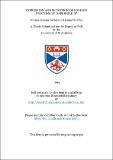Files in this item
Expression and secretion of foreign proteins by 'Aspergillus'
Item metadata
| dc.contributor.advisor | Kinghorn, James R | |
| dc.contributor.author | Da Silva, Norma Lucena Cavalcanti Licinio | |
| dc.coverage.spatial | 386 p. | en_US |
| dc.date.accessioned | 2018-06-08T14:35:33Z | |
| dc.date.available | 2018-06-08T14:35:33Z | |
| dc.date.issued | 1994 | |
| dc.identifier.uri | https://hdl.handle.net/10023/13857 | |
| dc.description.abstract | The feasibility of using the ascomycetes filamentous fungus Aspergillus oryzae as a host organism for foreign protein expression and secretion was assessed. For this purpose, human interleukin-6 (hIL-6) and the Simian virus 5 haemagglutinin-neuraminidase (HN) were used as model foreign proteins. Expression and secretion of the human interleukin 5 gene have been achieved using vector construction containing the entire A.niger glaA coding region linked to the hIL-6 cDNA through a KEX2-motif encoding DNA. hIL-6 containing expression vectors were introduced into A.oryzae nitrate non-utilising mutant strains nlaD14, niaD200, niaD500 (niaD-) and arginine auxotrophic strain 1560-6 (argB-) by means of genetic cotransformation technology. The A.oryzae niaD gene or the A.nidulans argB or amdS genes were used as the transfer and selection system. A.oryzae nitrate and acetamide prototrophic transformants, containing the hIL-6 DNA sequence, failed to secrete free hIL-6 molecules. Recombinant hIL-6 protein was detected in culture filtrates from A.oryzae 1560-6 arginine prototrophic transformants T1560-gla15 and T1560-gpd1. The results suggested that A.oryzae proteases recognized the KEX2-motif yielding free hIL-6 molecules. However, hIL-6 was found to be selective degraded by A.oryzae proteases compared with the heterologous glucoamylase (GLAA). The incubation time for hIL-6 detection has been shown to vary with the host strain and growth conditions. Hybrid GLAA/hIL-6 protein was also found to be secreted. Improvement in hIL-6 yields were obtained by generating 2-deoxy-D-glucose resistant mutants of transformant T1560-gla15 and by manipulating the host growth conditions including the use of microbial solid state culture. The maximum level of secreted hIL-6 was found to be approximately 4 mg/1 as judged from SDS-PAGE polyacrylamide gels and western blots analysis. The Simian virus 5 Haemagglutinin-neuraminidase (HN) glycosylation, folding and oligomerization characteristics have been well studied in mammalian cells. Therefore, HN is an ideal model protein, a priori, for studying secretion / processing in foreign hosts including filamentous fungi. For such studies the entire HN cDNA sequence (designated HN-DNA fragment) was generated by PCR technology. However, as the HN protein is a membrane bound glycoprotein type II, HN might not be secreted due to its anchor-domain, thus a deletion of the first 108 bp of its cDNA sequence, corresponding to the hydrophobic N-terminal region, was carried out in a second PCR reaction (designated ASSHN-DNA fragment). Both DNA fragments, encoding HN or ASSHN protein sequences, were inserted in-frame downstream of the A.niger glaA coding region in plasmid vector pAN56-30, generating pAN56-HN and pAN56-ASSHN. Additionally, both DNA fragments were inserted in-frame downstream of the A.oryzae amy3 gene present in vector pSTA1210, generating pSTA1210-HN and pSTAX210-ASSHN. These expression cassettes were introduced into A.oryzae 1560- 6, an amylase over-producing industrial strain, by means of cotransformation. The A.nidulans argB and amdS genes were used as transfer and selection systems. The HN protein was found in culture filtrates of arginine prototrophic transformants harbouring the glaA/ASSHN and amy3/ASSHN DNA sequences. HN protein was mainly detected by immunoprecipitation of 50 ml of culture filtrate. Such low expression level do not seem to be related to gene copy number, but rather to proteolytic degradation. Another possibility is that HN was not translated efficiently. Improvement in HN yield was achieved by cultivation on solid state culture in which HN protein was detected in 1 ml aliquot of culture filtrate as determine by western blotting. Nevertheless, the yield of HN protein extracted with 50 ml of sterile distilled water from 10 g rice solid state culture is estimated to be less than 1µg per ml as judged by the western blots | en_US |
| dc.language.iso | en | en_US |
| dc.publisher | University of St Andrews | |
| dc.subject.lcc | QH447.A8D2 | en |
| dc.subject.lcsh | Genomics | en |
| dc.title | Expression and secretion of foreign proteins by 'Aspergillus' | en_US |
| dc.type | Thesis | en_US |
| dc.contributor.sponsor | Brazilian Research Council CNPq | en_US |
| dc.type.qualificationlevel | Doctoral | en_US |
| dc.type.qualificationname | PhD Doctor of Philosophy | en_US |
| dc.publisher.institution | The University of St Andrews | en_US |
This item appears in the following Collection(s)
Items in the St Andrews Research Repository are protected by copyright, with all rights reserved, unless otherwise indicated.

